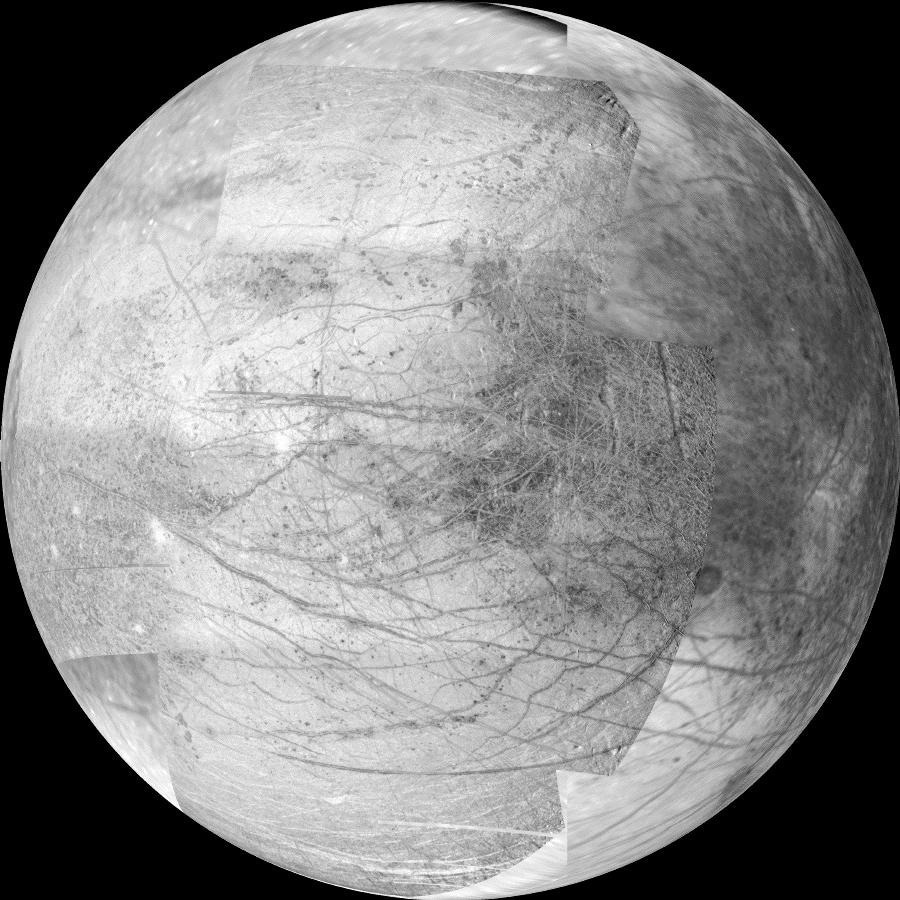Scientists have long been searching for the existence of life on planets other than Earth. An article recently published by the European Space Agency reported a recent study conducted by two groups of astronomers regarding the existence of life on Europa. This article delves into the details of the observations drawn by the two groups by interpreting the data obtained by renowned national research organizations using the James Webb Space Telescope.

Europa Jupiter-Facing Hemisphere. Image Credit: NASA/JPL/University of Arizona
What is Europa?
Europa is the fourth largest among the 16 known moons of Jupiter. The discovery of Europa has helped verify that planetary bodies apart from the Sun exert their own gravity. In space, Europa appears as a white sphere with brown cracks and splotches.
The major geological features of Europa are found on its surface. It has an outer icy crust and a possible ocean below it, which means that it is the only place apart from Earth to have liquid water.
The surface of Europa is highly reflective and has an atmosphere that is partially composed of oxygen. However, the oxygen is not breathable. There are also chances for the existence of life on Europa’s surface.
Existence of Life on Europa
Among many elements, carbon is essential for life, and its presence indicates habitable conditions. Europa is an icy moon of Jupiter with an ocean under a crust of ice. While the presence of carbon dioxide in a solid state was observed on its ocean’s subsurface, information on its source was elusive.
Astronomers of two different groups independently analyzed Europa’s data obtained from the National Aeronautics and Space Administration (NASA), European Space Agency (ESA), and Canadian Space Agency (CSA).
Images recorded using the James Webb Space Telescope (JWST) revealed the presence of carbon in a chaotic terrain on Europa’s icy surface called the Tara Regio, a newly formed terrain with many ridges, pits, domes, and cracks.
Mentioning Tara Regio, Dr. Geronimo Villanueva, a planetary scientist at NASA-Goddard Space Flight Center, said “The strongest signal is coming from the chaotic terrain, which is geologically fresher than other areas of Europa”.
Since the behavior of the material did not match what was expected if delivered by meteorites or other external sources, the astronomers confirmed its origin as internal, and since the chaotic terrain of Tara Regio itself is a recently formed region, the material is also new.
Why Study the Surface of Europa?
Previous studies have shown that ocean salt from Europa has surfaced in the same area that carbon dioxide has now surfaced, suggesting that, like salt, carbon dioxide also originated beneath the ice.
Mentioning the importance of studying Europa’s surface, Dr. Villanueva said, “we may be able to learn some basic things about the ocean’s composition even before we drill through the ice to get the full picture.”
The Role of the James Webb Space Telescope
The JWST was uniquely designed to conduct infrared astronomy. According to NASA, the JWST is a powerful telescope that identifies specific chemical substances on Europa and its location.
Both astronomer teams used data from the integral field unit of Webb’s Near-Infrared Spectrograph (NIRSpec). The instrument has the capacity to zoom in on areas of about 320 × 320 kilometers and identify the chemical and its location on Europa’s surface.
Due to carbon dioxide instability on Europa’s surface, researchers have inferred its supply on recent timescales. Furthermore, Heidi Hammel of the Association of Universities for Research in Astronomy mentioned that these observations were obtained within only a few minutes.
Finding Plume on Europa’s Surface
Based on the antecedents from 2013, 2016, and 2017, which hint at the presence of plumes observed through the Hubble Space Telescope, Villanueva's team investigated Europa’s surface for plumes of volatile material breaching the moon's icy crust.
However, recent observations using the Webb telescope did not detect any plume activity. While the team could specify the maximum amount of material that could be ejected from Europa, it did not eliminate the possibility of a plume. In addition, Hammel stated that the lack of plume detection did not confirm its absence.
These findings will be useful for future missions, such as the Europa Clipper mission of NASA and Jupiter Icy Moons Explorer, Juice, of the ESA. The latter, launched on April 14, 2023, will study the major moons of Jupiter, including Europa, to comprehend their potential habitats and roles in the Jupiter system.
Conclusion
Carbon is a building block for life, and the recent discovery of carbon dioxide on the surface of Europa using JWST has shed light on its potential existence on the oceanic subsurface of Europa. Additionally, this attempt also helped researchers to understand the chemical environment of Europa.
Although no plume activity was observed during the study period, this did not disprove its existence. These insights aid in further exploration of upcoming missions, such as the ESA's Juice and Europa Clipper, to delve deeper into Europa's mysteries. An increasing awareness of Europa revealed tantalizing opportunities that our Solar System holds in the discovery of habitable environments beyond Earth.
Reference:
Webb finds carbon source on surface of Jupiter’s moon Europa. European Space Agency (Accessed on 23 September 2023)
What is Europa? (Accessed on 23 September 2023)
Disclaimer: The views expressed here are those of the author expressed in their private capacity and do not necessarily represent the views of AZoM.com Limited T/A AZoNetwork the owner and operator of this website. This disclaimer forms part of the Terms and conditions of use of this website.